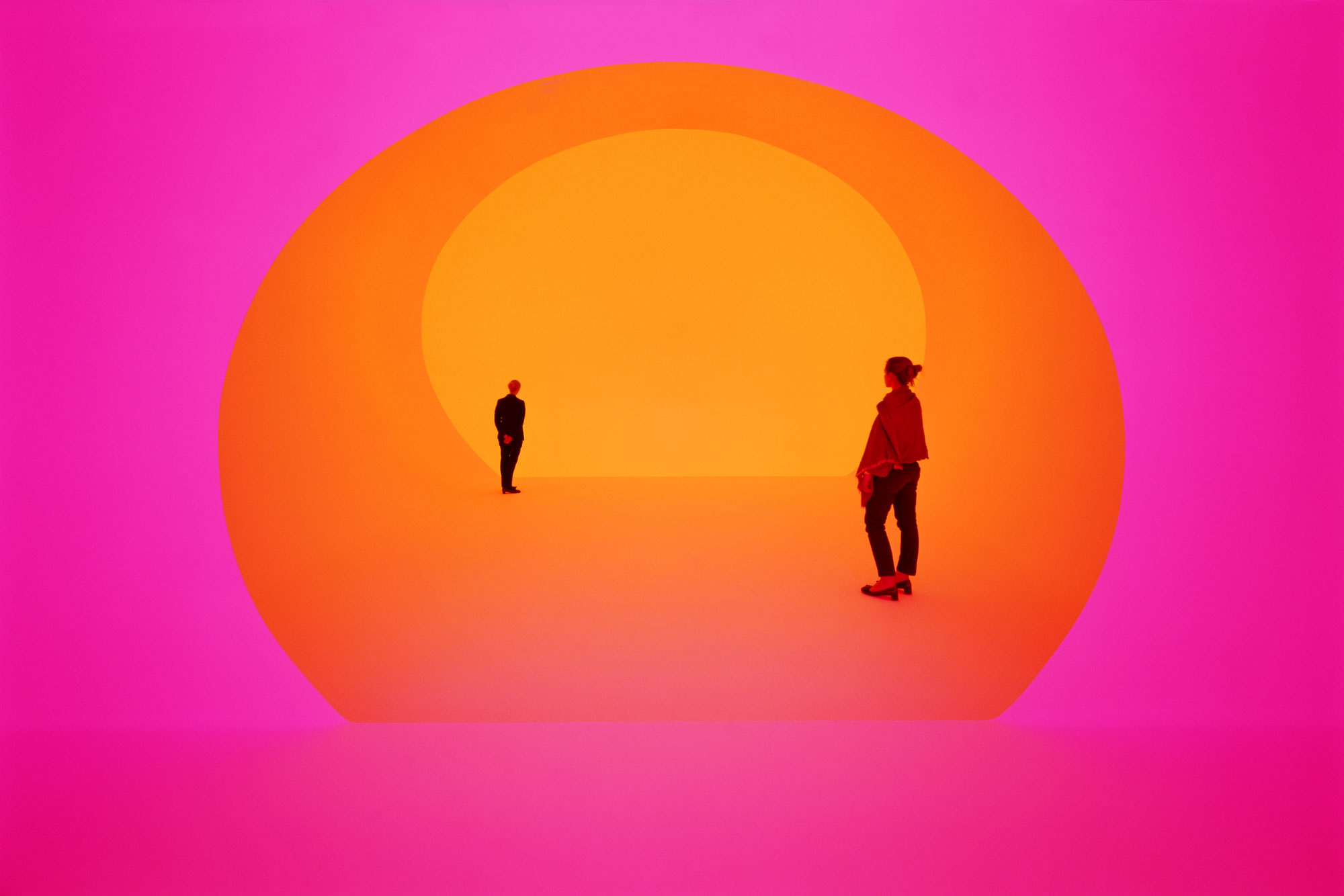The Aesthetic Turn: Media Aesthetics: Color for the Where and How
The Antenna blog has recently expressed an interest in exploring the “Aesthetic Turn” in media studies, or more specifically, the relationship between media and aesthetics, and where and how one can articulate such a theory. In this brief essay, I explore the provocative question of a theory of media aesthetics by way of the central yet paradoxical issues at the heart of color studies. Insofar as color is a primary tenet of visual studies – and media is here considered exclusively through the framework of the visual – then color may provide a fresh and unique lens to articulate a theory of media aesthetics. I begin with an anecdote that summarizes the complexity of these color problems.
In 1980, American light artist James Turrell’s solo exhibition at the Whitney Museum of American Art in New York City, “Light and Space,” reportedly caused “injury” not to one but to several spectators, resulting in two lawsuits filed against the Whitney. The first lawsuit was filed in Federal Court in 1982, by retired judge of the Oregon State Supreme Court Ralph M. Holman, on behalf of his wife, Louise, who charged that Turrell’s show created an “illusion” in which she became radically “disoriented and confused” and, as a result, was “violently precipitated to the floor.” The lawsuit sought an unspecified amount of damages from the artist. Also in 1982, a second suit was brought in front of the New York State Supreme Court by Mrs. Blanch Robins of New York, who charged that Turrell’s same exhibition caused her, after “stepping back against what she thought was a wall, to fall and permanently injure her right wrist.” Robins requested $250,000 compensation from the Whitney Museum. As extraordinary as these cases seem, they are not isolated incidents. In 1999, a pirated clip of Turrell’s artwork was inserted into a Pokémon cartoon which was then played on television in Japan, reportedly “setting off a rash of seizures and nausea that sent more than 700 people to the hospital,” many of whom were children and elderly people. Moreover, Turrell’s work with the medium of colored light is not alone in eliciting such responses.
In these examples, where does liability rest? Is the artist responsible for causing these injuries; the museum; or the spectator? The question is key not only because it forces a consideration of liability but also of the problems that lie at the heart of theorizing media aesthetics. Where and how do we begin to speak about media artwork? Where does it begin and end, and where and how does the subject fit into it all; extending from it (McLuhan), or rather, defining himself or herself against it? If a media artwork remains exclusive to a physical art-object, then one could argue that the artist or museum is responsible for the content they put on public display. But on the other hand, perhaps responsibility falls on the spectator, which is to say that art and aesthetics reside in subjective experience. Certainly this has been the answer for many in art and science since Goethe’s 1810 Theory of Colors.
These polarized positions delineate the two general ways in which color has traditionally been theorized in Western art and culture. On the one hand, it is argued that color inheres in things in the world, as an objective, physical, or quantifiable phenomena. For instance, “this oil pastel is yellow,” or “this apple is red.” Followers of this school tend to include theorists like Aristotle, the classical opticians (including Kepler, Galileo, Descartes, and Newton), factions of modern science, technology industries, chemistry, physics, and certain industrial color ordering systems. On the other hand, it is argued that color is a subjective phenomenon that alters according to the physiology of the perceiver. For example, in the above image from 20th century colorist Josef Albers, he showed how the same neutral brown changed its hue and value based on its surrounding colors. Traditionally, artists, modern philosophers (including Goethe), and certain sub-sections of modern science, like psychophysics and psychology, tend to follow this view.
At the same time, as a phenomenon of subjective experience, color becomes strange and estranged; inconsistent, unreliable, and, for some – a deceptive simulacra. Such a fear and distrust of color dates back to the origins of Western metaphysics. Sophists, rhetoricians, and painters – i.e., those who write with color – deemed “creator[s] of phantoms,” Plato argued; “technicians of ornament and makeup.” But by far the most poisonous of simulacra is color: a cosmetic and false appearance that, like the sophist’s “gaudy speeches” and “glistening words” seduce the listener with their ambiguity and sparkle, but unlike words, carry no representational value beyond itself. Color holds to nothing and to no one. This elusiveness has given numerous philosophers license for its romanticization, from Goethe to Heidegger, Wittgenstein, Benjamin, Barthes, Baudrillard, Derrida, and even Adorno. (Benjamin in 1914: “The imagination can be developed only by contemplating colours… pure vision is concerned not with space and objects but with colour”; Heidegger in 1935: “Color shines and only wants to shine. When we analyze it in rational terms by measuring its wavelengths, it is gone”; and Baudrillard in 1995: “No analysis of the vibrations of light will ever explain the sensory imagining of colours…”). In short, the denial of subjective responsibility in aesthetic experience no doubt contributes to the problems with a theory of media aesthetics (not to mention legal liability).
Moving forward, Turrell’s work (alongside others in this genre that must be discussed at length elsewhere) embodies the paradoxical tensions between subject and object at the heart of media art. Many factors – an artist’s intention and conception, installation, audience reception, the relation to the museum architecture, the number of people in the museum, and the cultural and physiological background of the viewer, which shapes their perception and color vision – all count. All of these factors work together in what must be called “media aesthetics.” Future theories of media aesthetics need to note such ambivalences and crossovers.
This is the third post in Antenna’s new series The Aesthetic Turn, which examines questions of cultural studies and media aesthetics. The first two posts were written by series guest editor Kyle Conway. If you missed either of those, they can be read here. Look out for regular posts in the series (most) every other Wednesday in December, January, and beyond.






Thank you for continuing this series with another thought-provoking entry. After returning to Kyle’s inaugural post for some perspective, I wonder if you can expand a little on your particular understanding of the “aesthetic turn” in media studies, since I could see each contributor taking a slightly unique approach. Specifically, Kyle ends by expressing an interest in “the aesthetic experience of the media,” the “gut reaction” to media, as he calls it. It appears as though you are taking up slightly different issues, particularly related to the utility of media. Could you explain a bit more about the distinction between “aesthetics” and “media aesthetics” as you see it?
Leo,
Thanks for your comment. I’m very pleased to have Carolyn’s contribution, and I’m glad the series has found readers.
As for the “aesthetic turn,” I borrowed the phrase from Shawn VanCour’s post, “New Directions in Media Studies: The Aesthetic Turn”. I understand it as a line of questioning that has become prominent among cultural studies-oriented scholars (although the questions we’re posing aren’t necessarily new, I’m discovering, just new to us). But “line of questioning” is rather broad, and the “turn,” such as it is, encompasses a wide range of interests, from the “production-oriented approach” Shawn advocates to questions about the philosophy of art.
Part of the reason I proposed this series to the Antenna editors was to draw together a wide range of people to see what common themes emerged.
I have to go teach, but I have more to add — I’ll try to come back this evening!